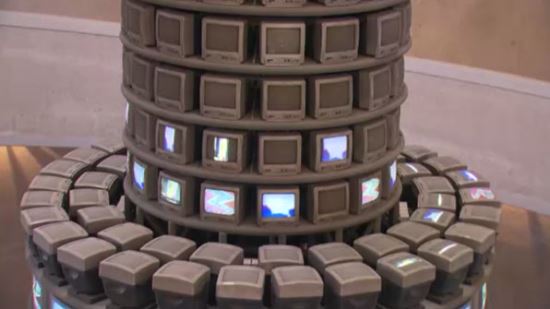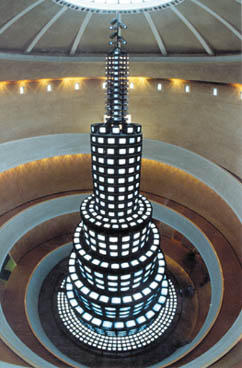Recent Posts
Research Critique: Cybernetics, Nam June Paik and Magnet TV

Cybernetics
In 1948, Norbert Wiener derived this word from a Greek word, cybernēticḗ (meaning governance), and defined as “the scientific study of control and communication in the animal and the machine” in his essay. Nam June Paik described the impact of it as “the exploration of boundary regions between and across various existing sciences”1. Yet, Ascott suggested that the spirit of cybernetics “offers Read more →
Research Critique: Robert Rauschenberg, "Soundings", 1968

Soundings is a 36 by 8 foot voice responsive object by Robert Rauschenberg.
The construction consists of nine eight-foot high units, three layers deep of plexiglass panels. The outer panels are silvered. When the observer enters the room in which the construction is installed, he sees his own reflection in the silvered panels. The work is electronically Read more →
Class 2 Reading Assignment Vocabulary

Research Critique: Nam June Paik, "Magnet TV", 1964

https://www.youtube.com/watch?v=L-TsvjJAfmg
Nam June Paik, MAGNET TV, 1965
An altered television set combined with a magnet sitting on top is unlike the majority of artworks back then. It is not an autarchy. This screen does not broadcast fixed programme but shows a crooked moving abstract image, that can be manipulated at will.
Norbert Wiener’s 1954 essay “ Read more →
 Nam June Paik, 다다익선(多多益善), 1988
Nam June Paik, 다다익선(多多益善), 1988

What Is My Aspect of Multimedia

Forward
In my perspective, multimedia is defined as a culture and aesthetics communication based on the technological medium. It could be also regarded as a collaboration between artists and scientists. In the overture of this book, the author introduced the evolution of multimedia from World War II (the first computer produced) to twentieth century artists’ efforts (visual arts, performance and so Read more →
Imagine the art of the future, mutimedia

Even before analyzing the word or the history of “multimedia”, I have pre-conception. Whenever I saw the multimedia or interactive art exhibited in Seoul, there were always some problems. The works supposed to move were stopped because of the safety problem or sometimes even the artists just left them because they couldn’t fix it during the exhibition. And if Read more →
My Learning from Overture

The Overture essay briefly describes a long ‘secret history’ of multimedia which includes the birth of multimedia, the pioneer activities promoting the development of multimedia, as well as the future of multimedia. These parts of contents provide a new understanding of the concept and history of multimedia for me, for example, I never realized that the origins of Read more →
Thinking afresh about multimedia

In the overture of the book, Multimedia: From Wagner to Virtual Reality, 2001, the authors presented that multimedia experience dates way back, to as early as 15000 BCE of the cave paintings of Lascaux. And the theory of multimedia has been established in 1849 by Wagner as “Gesamtkunstwerk”, or “Total Artwork”.
My initial encounter with the Read more →
My Understanding of Multimedia

In my view, I regard multimedia as a pure medium that combines sound, images carrying nothing meaningful. However, after I read the content in the overture part, it surprised me that the meaning of multimedia is not just a tool, but also a carrier that loads the creativity and intelligence of human beings, and a breakthrough that changes the inherent Read more →
My History of Multimedia

The history of multimedia begins with the Korean shaman ceremony.